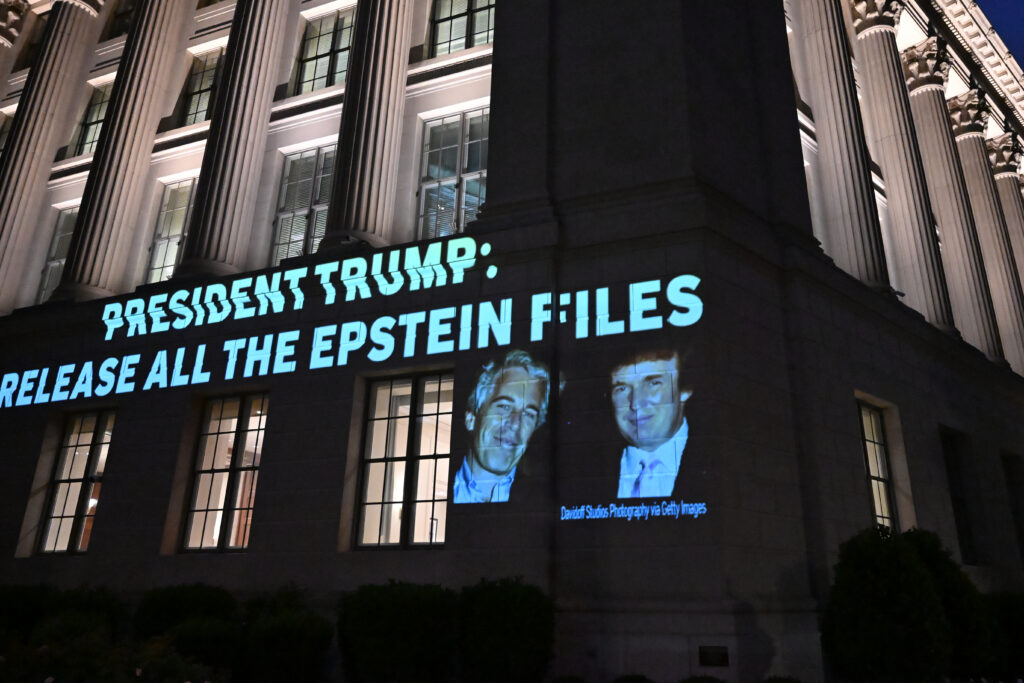Trump est arrivé en Ecosse pour un séjour mêlant golf, diplomatie et commerce
Donald Trump est arrivé vendredi pour un week-end prolongé en Ecosse qui doit mêler golf, diplomatie et négociations commerciales, et où un important dispositif de sécurité a été déployé en prévision de manifestations.”Je suis en Ecosse maintenant. Beaucoup de réunions prévues!!!”, a annoncé le président américain sur son réseau Truth Social.Après son arrivée à bord de l’avion présidentiel Air Force One en début de soirée à l’aéroport de Prestwick, au sud-ouest de Glasgow, Donald Trump s’est rendu à Turnberry, dans un des deux complexes de golf écossais appartenant à l’entreprise familiale dirigée par ses fils.L’agenda officiel du président américain est vide samedi. Il doit rencontrer dimanche la présidente de la Commission européenne Ursula von der Leyen, qui espère obtenir un accord sur les droits de douane. Une perspective que le président américain a jugé possible à “50-50”.La police écossaise, qui se prépare à des manifestations, a annoncé la mise en place d’une “opération d’envergure à travers tout le pays pendant plusieurs jours”.Avant de repartir pour Washington, Donald Trump s’arrachera aussi aux greens pour une rencontre, dont les détails ne sont pas connus, avec le Premier ministre britannique Keir Starmer.Ce dernier ne passe pas pour être féru de golf comme le républicain de 79 ans et il cherchera surtout à rester dans ses petits papiers, après avoir jusqu’ici évité que son pays ne soit frappé de droits de douane exorbitants.Les Etats-Unis et le Royaume-Uni ont annoncé en mai un accord commercial, mais Londres s’inquiète de la volonté exprimée par Donald Trump de le “peaufiner”.A son arrivée en Ecosse, Donald Trump a toutefois affirmé que l’heure serait à la “célébration”. “L’accord est conclu” avec Londres, a-t-il insisté, ajoutant que les deux dirigeants parleraient “d’autres choses”.Avant son départ de Washington, il a néanmoins semblé doucher les espoirs britanniques d’obtenir des droits de douane durablement réduits sur l’acier et l’aluminium. Londres a jusqu’ici été exempté des 50% de droits appliqués aux importations par les Etats-Unis. “Si je le fais pour un, je devrais le faire pour tous”, a-t-il affirmé.- Immigration -En Ecosse, la guerre dans la bande de Gaza sera sans doute un sujet de discussion, au moment où le Premier ministre travailliste est appelé par plus de 220 députés à emboîter le pas au président français Emmanuel Macron pour reconnaître l’Etat de Palestine.A son arrivée, Donald Trump a également évoqué l’immigration en Europe, appelant les pays européens “à se ressaisir” et à “mettre un terme à cette horrible invasion”, en prenant exemple sur sa propre politique d’expulsions de sans-papiers.En traversant l’Atlantique, Donald Trump sera à distance, au moins géographiquement, des rebondissements de la très embarrassante affaire Jeffrey Epstein, un riche financier accusé de crimes sexuels et mort en prison en 2019 avant son procès.Certains de ses partisans lui reprochent de manquer de transparence à propos de cette ancienne figure de la jet-set new-yorkaise, avec laquelle lui-même entretenait une relation amicale et qui est devenue le symbole pour toute une frange du mouvement “MAGA” des turpitudes d’une élite protégée.Depuis l’Ecosse, il a assuré n’avoir jamais été “informé” que son nom figurait dans les dossiers judiciaires liées à l’ancien financier.Donald Trump sera de retour au Royaume-Uni en septembre, pour une visite d’Etat à l’invitation du roi Charles III s’annonçant fastueuse.- Manifestations -Il avait assuré au cours d’une précédente visite, en 2023, se sentir “à la maison” en Ecosse où sa mère, Mary Anne MacLeod, a grandi avant d’émigrer à 18 ans aux Etats-Unis.Son affection n’est pas forcément réciproque: des manifestations sont prévues samedi à Edimbourg et à Aberdeen, ainsi qu’à proximité de ses golfs, pour protester contre sa présence.En 2018, sa précédente visite à Turnberry avait poussé des milliers de personnes à manifester à Glasgow et à Edimbourg.Le Premier ministre écossais, John Swinney, a annoncé qu’il rencontrerait Donald Trump pendant sa visite, soulignant que l’Ecosse “entretient une amitié solide avec les Etats-Unis depuis des siècles”. La construction d’un nouveau parcours par le groupe aujourd’hui dirigé par les fils de Donald Trump a suscité du mécontentement à Balmedie, dans l’Aberdeenshire, de la part de certains riverains et d’élus écologistes.Ce n’est que l’un des nombreux projets, immobiliers ou autres, à travers le monde de la famille Trump.Si Donald Trump n’a plus légalement le contrôle de la holding familiale, ses opposants lui reprochent de multiplier les conflits d’intérêts en se servant de ses fonctions de président pour pousser des investissements familiaux privés, notamment à l’étranger.
Trump est arrivé en Ecosse pour un séjour mêlant golf, diplomatie et commerce
Donald Trump est arrivé vendredi pour un week-end prolongé en Ecosse qui doit mêler golf, diplomatie et négociations commerciales, et où un important dispositif de sécurité a été déployé en prévision de manifestations.”Je suis en Ecosse maintenant. Beaucoup de réunions prévues!!!”, a annoncé le président américain sur son réseau Truth Social.Après son arrivée à bord de l’avion présidentiel Air Force One en début de soirée à l’aéroport de Prestwick, au sud-ouest de Glasgow, Donald Trump s’est rendu à Turnberry, dans un des deux complexes de golf écossais appartenant à l’entreprise familiale dirigée par ses fils.L’agenda officiel du président américain est vide samedi. Il doit rencontrer dimanche la présidente de la Commission européenne Ursula von der Leyen, qui espère obtenir un accord sur les droits de douane. Une perspective que le président américain a jugé possible à “50-50”.La police écossaise, qui se prépare à des manifestations, a annoncé la mise en place d’une “opération d’envergure à travers tout le pays pendant plusieurs jours”.Avant de repartir pour Washington, Donald Trump s’arrachera aussi aux greens pour une rencontre, dont les détails ne sont pas connus, avec le Premier ministre britannique Keir Starmer.Ce dernier ne passe pas pour être féru de golf comme le républicain de 79 ans et il cherchera surtout à rester dans ses petits papiers, après avoir jusqu’ici évité que son pays ne soit frappé de droits de douane exorbitants.Les Etats-Unis et le Royaume-Uni ont annoncé en mai un accord commercial, mais Londres s’inquiète de la volonté exprimée par Donald Trump de le “peaufiner”.A son arrivée en Ecosse, Donald Trump a toutefois affirmé que l’heure serait à la “célébration”. “L’accord est conclu” avec Londres, a-t-il insisté, ajoutant que les deux dirigeants parleraient “d’autres choses”.Avant son départ de Washington, il a néanmoins semblé doucher les espoirs britanniques d’obtenir des droits de douane durablement réduits sur l’acier et l’aluminium. Londres a jusqu’ici été exempté des 50% de droits appliqués aux importations par les Etats-Unis. “Si je le fais pour un, je devrais le faire pour tous”, a-t-il affirmé.- Immigration -En Ecosse, la guerre dans la bande de Gaza sera sans doute un sujet de discussion, au moment où le Premier ministre travailliste est appelé par plus de 220 députés à emboîter le pas au président français Emmanuel Macron pour reconnaître l’Etat de Palestine.A son arrivée, Donald Trump a également évoqué l’immigration en Europe, appelant les pays européens “à se ressaisir” et à “mettre un terme à cette horrible invasion”, en prenant exemple sur sa propre politique d’expulsions de sans-papiers.En traversant l’Atlantique, Donald Trump sera à distance, au moins géographiquement, des rebondissements de la très embarrassante affaire Jeffrey Epstein, un riche financier accusé de crimes sexuels et mort en prison en 2019 avant son procès.Certains de ses partisans lui reprochent de manquer de transparence à propos de cette ancienne figure de la jet-set new-yorkaise, avec laquelle lui-même entretenait une relation amicale et qui est devenue le symbole pour toute une frange du mouvement “MAGA” des turpitudes d’une élite protégée.Depuis l’Ecosse, il a assuré n’avoir jamais été “informé” que son nom figurait dans les dossiers judiciaires liées à l’ancien financier.Donald Trump sera de retour au Royaume-Uni en septembre, pour une visite d’Etat à l’invitation du roi Charles III s’annonçant fastueuse.- Manifestations -Il avait assuré au cours d’une précédente visite, en 2023, se sentir “à la maison” en Ecosse où sa mère, Mary Anne MacLeod, a grandi avant d’émigrer à 18 ans aux Etats-Unis.Son affection n’est pas forcément réciproque: des manifestations sont prévues samedi à Edimbourg et à Aberdeen, ainsi qu’à proximité de ses golfs, pour protester contre sa présence.En 2018, sa précédente visite à Turnberry avait poussé des milliers de personnes à manifester à Glasgow et à Edimbourg.Le Premier ministre écossais, John Swinney, a annoncé qu’il rencontrerait Donald Trump pendant sa visite, soulignant que l’Ecosse “entretient une amitié solide avec les Etats-Unis depuis des siècles”. La construction d’un nouveau parcours par le groupe aujourd’hui dirigé par les fils de Donald Trump a suscité du mécontentement à Balmedie, dans l’Aberdeenshire, de la part de certains riverains et d’élus écologistes.Ce n’est que l’un des nombreux projets, immobiliers ou autres, à travers le monde de la famille Trump.Si Donald Trump n’a plus légalement le contrôle de la holding familiale, ses opposants lui reprochent de multiplier les conflits d’intérêts en se servant de ses fonctions de président pour pousser des investissements familiaux privés, notamment à l’étranger.
Top US Justice official questions Epstein accomplice for 2nd day
The US Justice Department’s deputy chief conducted a second day of questioning Friday with Ghislaine Maxwell, the imprisoned accomplice of late sex offender Jeffrey Epstein, whose infamous case has dragged President Donald Trump into a political firestorm.Todd Blanche, who is also Trump’s former personal attorney, has so far declined to say what he discussed with Maxwell in the highly unusual meetings between a convicted felon and a top DOJ official.Maxwell’s lawyer David Markus said Friday afternoon that she was asked about “everything” and “answered every single question” during the second day of questioning at a courthouse in Tallahassee, Florida.”They asked about every single, every possible thing you could imagine,” Markus told reporters outside the courtroom, without elaborating.But he did say there was “no offers” of clemency made to Maxwell, who is serving a 20-year sentence on sex trafficking charges.Trump is looking to move past the Epstein scandal, which has seen him on rare unsure footing over claims his administration mishandled a review of the notorious case.On Friday, Trump again sought to put distance between himself and Epstein, the disgraced financier who died in jail in 2019 while awaiting trial on sex trafficking charges.”I have nothing to do with the guy,” Trump, whose past friendship with Epstein has received much media attention this week, told reporters ahead of a visit to Scotland.- ‘Never briefed’ -Trump urged journalists to “focus” instead on Democratic Party figures like former president Bill Clinton and his treasury secretary, former Harvard president Larry Summers, whom the Republican claimed were “really close friends” of Epstein.Asked whether he was considering a pardon or commutation of Maxwell’s 20-year prison sentence for sex trafficking, Trump said it was something “I haven’t thought about” — but stressed he had the power to do so.He also denied multiple US media reports that he was briefed in the spring by Attorney General Pam Bondi that his name appeared multiple times in the so-called “Epstein Files.””No, I was never — never briefed, no,” Trump said.Multi-millionaire Epstein was accused of procuring underage girls for sex with his circle of wealthy, high-profile associates when he died by suicide in a New York jail cell.His death fueled conspiracy theories that he was murdered to stop him testifying against prominent accomplices.Trump, who had promised his supporters revelations about the case, infuriated some after his administration announced in early July that it had not discovered any new elements warranting the release of additional documents.The Department of Justice and the FBI said there was no proof that there was a “list” of Epstein’s clients, while affirming he died by suicide.- ‘Scapegoat’? -Ahead of the second round of questioning, Markus told reporters “Ghislaine has been treated unfairly for over five years now” and described her as a “scapegoat.””Everything she says can be corroborated and she’s telling the truth. She’s got no reason to lie at this point and she’s going to keep telling the truth,” he added.Maxwell, the only former Epstein associate who has been convicted, was jailed in 2022 for grooming underage girls between 1994 and 2004 so that Epstein could sexually exploit them.Her lawyer said she still intended to appeal her conviction in the Supreme Court.The Wall Street Journal reported Wednesday that Trump’s name was among hundreds found during a DOJ review of Epstein’s case files, though there has not been evidence of wrongdoing.Trump filed a $10 billion defamation suit against the Journal last week after it reported that he had penned a sexually suggestive letter to Epstein for his 50th birthday in 2003.House of Representatives Speaker Mike Johnson cut short the legislative session this week, sending lawmakers home on summer recess a day early to avoid potentially combustible debate — particularly among Trump’s Republicans — on the release of files.



